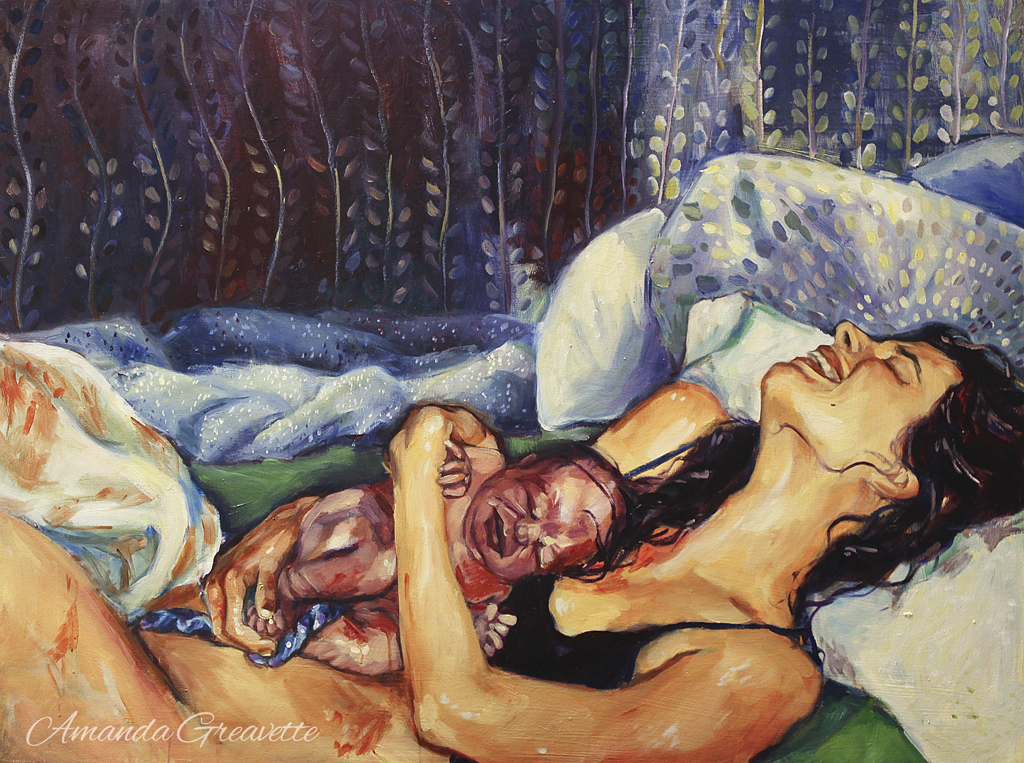Elation after Birth in the Work of Amanda Greavette
It’s a Human Thing (It’s a Girl?? It’s a Girl!!), 48″ x 36″, oil on canvas
(Copyright 2012 [Version 1 created in 2007] Amanda Greavette. All Rights Reserved)
Returning to the artwork of Amanda Greavette, we focus on the artist’s glorious painting, It’s a Human Thing (It’s a Girl?? It’s a Girl!!). The piece is a self-portrait, depicting the artist after she had given birth to her second child, a daughter (Greavette has five children). Greavette’s husband comes from a long line of boys, and she did not expect that she would have a girl although she yearned deeply for one. The title of the work comes from a song written by The Be Good Tanyas, one of Greavette’s favorite bands, and the music of which she had listened to during her labor.
While the colors and form of this work are exquisite, the representation of fleshly post-birth experience, combined with deep human emotion, is remarkable. Greavette has described this to me in our correspondences,
This piece was about the universality of that elation (especially in a self-directed, empowered birth) post birth, when you are so high from having just birthed and received your child. I wanted to show the other-worldliness or euphoria the mother often experiences, even while her body isn’t fully pulled together yet from the drama of the birth- the position of the figure was intentional to convey that sliding around feeling or looseness immediately after birth, when the body and one’s control of it is in fact secondary to the experience. The body is often very vulnerable and exposed but that is greatly overshadowed by the intensity of meeting one’s child. And that delight and joy might be intensified by discovering a desired gender/sex, like in my case!
The fleshly aspects of birth are still rarely seen in art, especially in painting, but back in 2007 when Greavette first painted this work, this type of representation was particularly hard to find. Greavette, aware of this at the time, notes,
At the time of painting I wanted to convey the rawness of birth- the blood and umbilical cord at the time were unusual in art or birth photos.
Greavette’s work can help pregnant women prepare for birth in a number of ways. First, the work normalizes the physicality of birth, showing women that giving birth naturally involves the presence of blood and fleshly matter, such as an umbilical cord. As opposed to the impression we get from sterile images of birth as it occurs shrouded in hospital gowns and caps, Greavette’s image reminds us that birth is not a “clean” matter as such. The painting also reminds the pregnant woman that she too will eventually finish her labor and have her baby in arms. Sometimes, especially when a woman is pregnant for the first time and even more so if she is past her due date, she becomes anxious and cannot imagine “getting the baby out” (I have written about this issue and my experience with it, as well as how to remedy it here) Images such as Greavette’s can help others to envision their babies as already born. Finally, the work imparts on the viewer an impression of the deep emotional impact of which giving birth and being with one’s baby for the first time from outside the womb is capable.
See Visualizing Birth here, and here for more posts on Greavette’s stunning work.
Amanda Greavette is a Canadian artist who lives and works in Ontario. In addition to painting and working in her community, Greavette is raising five children. She is also a La Leche League leader. To view more of Greavette’s work or to visit her Etsy shop, see her website information.
